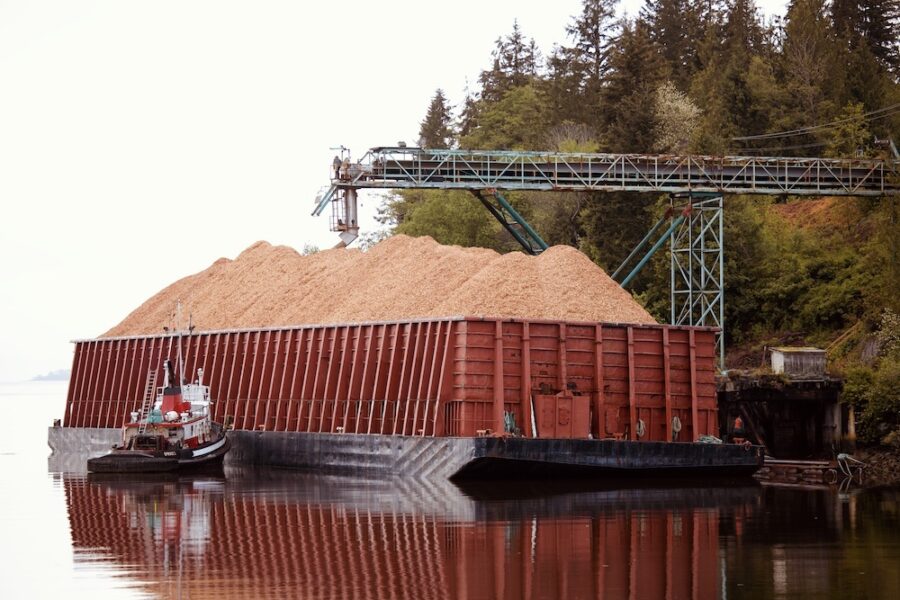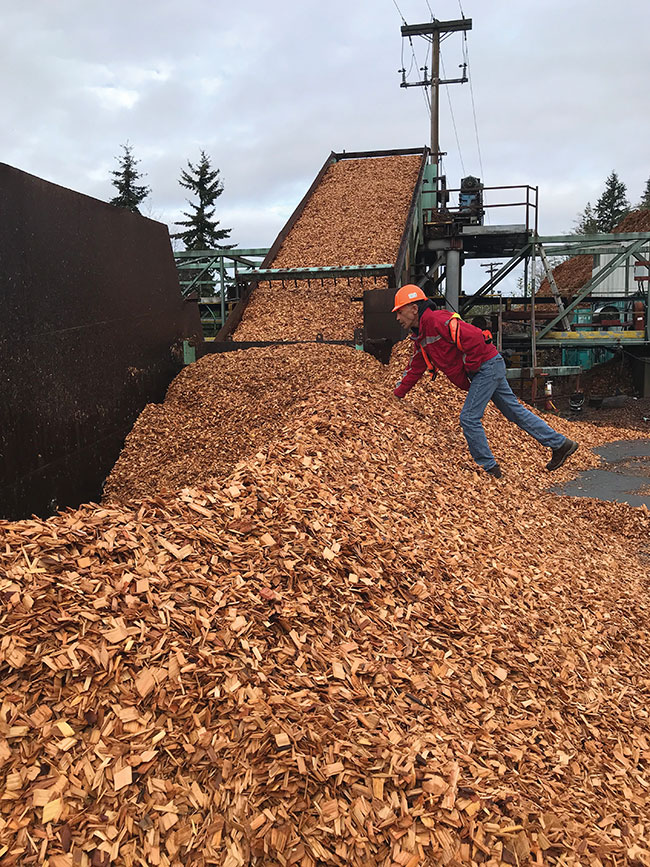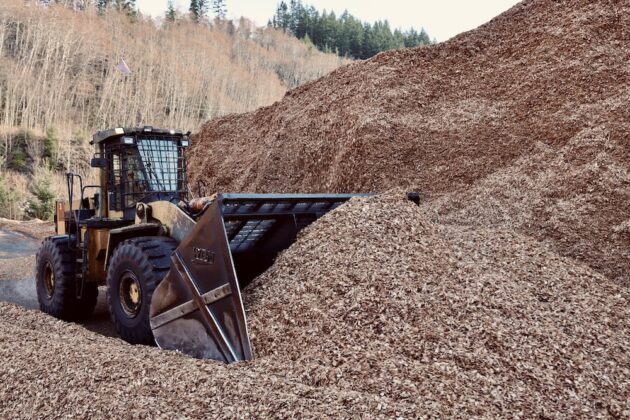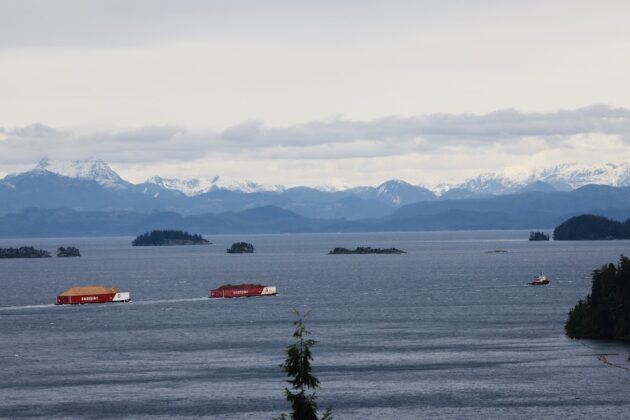
Chipping champions: Atli Chip LP adds value to Island logging residues
February 13, 2023
By
Maria Church
Atli Chip CEO Doug Mosher says partnerships and policies have made the chip plant an integral component of B.C.'s coastal bioeconomy.
 Barges bring wood chips from Atli Chip in Beaver Cove, B.C., to pulp mills along the coast. Photo courtesy Atli Chip.
Barges bring wood chips from Atli Chip in Beaver Cove, B.C., to pulp mills along the coast. Photo courtesy Atli Chip. A humble chipping plant is grinding out economic benefits in Northern Vancouver Island, creating value from salvage wood that would otherwise be burned as a by-product of logging operations.
Atli Chip in Beaver Cove processes around 200,000 cubic metres of salvage fibre, supplying chips and hog fuel to B.C.’s coastal pulp mills.
The chip plant came under new co-ownership in 2021. The ‘Namgis First Nation’s beneficially owned Atli Resources Limited Partnership owns 60 per cent of the operation, Vancouver Island logger Wahkash Contracting owns 25 per cent, and pulp and paper giant Paper Excellence owns 15 per cent.
Atli Chip CEO Doug Mosher, a registered professional forester with over 35 years of experience working in resource industries, says partnerships and policies have made the chip plant an integral component of the coastal bioeconomy.
“There are incentives now for forest licensees to, rather than leave fibre in the woods and later burn it or let it rot, to bring it to the chip plant. It’s really turned a corner. And we’ve built relationships with forest licensee and private suppliers to make this all happen,” Mosher says.

The Vancouver Island chip plant processes around 200,000 cubic metres of salvage wood each year. Photo courtesy Atli Chip.
The main policy driver was in 2020 when B.C. introduced fibre recovery zones that penalize forest companies for what is considered excessive slash in areas deemed economical to haul out. The coast fibre recovery zone covers significant portions of Vancouver Island and the mainland coast where primary harvesters pay triple the waste rate (stumpage) for “avoidable” slash left on a harvest block.
Anticipating a flood of salvage fibre hitting the market, Atli Chip’s owners jumped on the opportunity to work together to capitalize on their location and expertise.
The chip plant site was constructed about 20 years ago as a biomass power plant. The owners sold shortly after to a salvage and dryland sort company that operated it as a chip plant, supplying fibre to coastal pulp mills.
The ‘Namgis First Nation, under their forestry economic development corporation Atli Resources LP, purchased and took a majority stake in the company in 2021, working in partnership with the nearby pulp mills, owned by Paper Excellence, and local logger Wahkash Contracting. Atli Chip Limited Partnership was born.
The three partners are not only in name – their staff and contractors play pivotal roles in the day-to-day operations to turn logging residues into profit.
From stand to chip
Fibre heading to Atli Chip is first handled by various forest companies. Any residual fibre within the recovery zones or within economic hauling distances are then collected by salvage contractors overseen by Atli Resources.
Mosher says the longest round trip for sourcing salvage is around five hours. Any longer and the fuel costs eat up any profit from the fibre.
“The distance is less important than the quality of roads. If they’re just off the highway, that’s fine. But most of the wood is in the old growth areas and a lot of that is in the mountains. It’s slower going, steeper in a lot of places, and you can’t get everything out of there,” Mosher says.

Chip and hog product is piled on the site’s concrete pad, ready for transporting to waiting barges. Photo courtesy Atli Chip.
Once fibre enters the chip plant’s gates, full-time Atli Chip employees take over the process, overseen by Wahkash Contracting’s co-owner and plant manager Warren Roberts and office manager Ashley Boese. Logs are weighed and piled up in the yard, anything from two-foot “chunks” up to 25 feet in length and 30 inches in diameter.
A continuous flow of logs are fed into a hefty 25-foot DEAL processor – a cradle-style debarker top fed by mobile equipment, which includes a Komatsu front-end loader, Hitachi log loader and a Caterpillar grapple loader.
The debarked fibre then runs via Belterra conveyor belts in the “big black hole,” Mosher says, that is the Carthage 12-knife, 2,800-hp chipper.
“This chipper is quite a unique one from what we’ve been told by the experts because it takes some of the most diversified fibre, at least in the province. It can handle the small chunks and not just round logs,” Mosher says. This sets Atli Chip out from your typical chipping plant. But with that uniqueness comes higher costs that need to be carefully managed and, ultimately, paid for by the customer.
The chips are then sent through a USNR double deck 10×20-foot screen to filter out different sizes. A 2-inch round hole top overs screen and a ¼-inch round hold fines screen. A Columbia Machine Works grizzly re-chips oversize with the re-chipped material blow back to re-screen.
Chip and hog product is then piled on the site’s concrete pad, ready for transporting via loaders and conveyors and a Pullmaster Winch Corp. donkey that moves the waiting barges into position. Once loaded onto barges, the products are managed entirely by Paper Excellence, which ships them to their pulp mills for processing.

Atli Chip processes around 200,000 cubic metres of salvage fibre, supplying chips and hog fuel to coastal pulp mills. Photo courtesy Atli Chip.
Progress with partners
Like most businesses, industry partnerships are an essential cog to Atli Chip’s profitability.
The chip plant has struck deals with the large licensees, private landowners, dryland sort operators and forest management companies in the area, including Western Forest Products and Mosaic Forest Management. Western has made significant volumes of harvest residue and pulp logs available to Atli Chip from two of their tree farm licenses and private land in the area. Mosaic and Wahkash Contracting have delivered significant volumes of residue fibre and pulp logs directly from their field operations. Mosaic has also allowed Atli Chip access to their dewatering property when needed to process fibre brought in on log barges from further away.
The chip plant has also benefited from support from the Forest Enhancement Society of BC, and Natural Resources Canada’s Indigenous Forestry Initiative.
FPInnovations is another partner. “They have been helping us out on various aspects of the operations, giving advice or making suggestions,” Mosher says.
“Atli Chip is also grateful to Tale’Awtxw Aboriginal Capital Corporation who provided initial financing assistance and on-going business expertise,” says Jim Bennett, Atli Resources’ director and treasurer. “Many people came together to make this project happen and is a great example of interested partners working together for the common good.”
Eye on the future
In order to keep a chip plant running, it must have access to old-growth logging sites, Mosher says. Second-growth logging does not produce the volume of harvest residues needed to support a plant running full time. That volume also needs to be sourced locally enough to make economic sense.
Atli Chip has its sights set on a few new sources of fibre as it navigates B.C.’s changing forest landscape. As the province continues to incentivize projects to reduce slash-pile burning and produce secondary products, there may be grant opportunities to ship fibre from further away, or to source historical fibre from blocks where slash is piled but not yet burned.
“There are many moving parts with government policy: dealing with old growth and working with First Nations reconciliation,” Mosher says. “We’re watching that right now very closely to see how we can adapt.”
Atli Chip is eyeing a few on-site expansion projects as well, including increasing the size of their log yard and hog fuel storage areas, which would give them more flexibility in run times with more on-site storage.
“For Atli Chip, our big push, is to adapt and be innovative, and to work with our partners – and that includes the major forest license holders, neighbouring First Nations and community landowners. If we’re all working together, it gives us a better chance of producing a good chip product and keeping employment going,” Mosher says.
Print this page